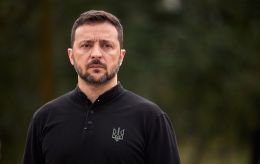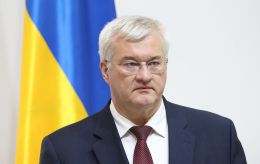Media reveals deal Russia offered to Ukraine at the beginning of the full-scale invasion
 Photo: Russia offered Ukraine an agreement, which is actually a demand to surrender (Twitter)
Photo: Russia offered Ukraine an agreement, which is actually a demand to surrender (Twitter)
At the beginning of the full-scale war, Russia offered Ukraine a “peace deal” that resembled a demand for surrender. Among the proposals were reducing the Ukrainian army, no support from the West, and Kyiv's obligation to pay for the restoration of Donbas, according to Radio Liberty.
Structure of the document
According to the media, the draft is titled “Agreement on the Settlement of the Situation in Ukraine and the Neutrality of Ukraine,” dated March 7, 2022, 11 days after Russia launched a full-scale invasion and a week after negotiations between Kyiv and Moscow began.
The document was created by the Kremlin and handed over to the Ukrainian delegation on March 7, 2022, during the third round of Russia-Ukraine talks in Belovezhskaya Pushcha in Belarus. According to the article, this is the first known document that sets out the Russians' conditions for a peace agreement after the start of the full-scale invasion.
“If the Ukrainian authorities agreed to these conditions, it would turn Ukraine into a puppet state with a fictitious neutral status, a tiny toothless army, no protection from NATO countries, and no chance to regain control of Crimea or Donbas, and it would have to recognize the independence of the Donetsk and Luhansk regions as a whole, as well as large areas that were still under Kyiv's control at the time,” the article says.
The draft contains 6 pages of the main agreement and 4 pages of annexes. The 18 articles cover various areas: the parameters of Ukraine's neutrality (military and international obligations), border issues, humanitarian issues (language, religion, history), and the lifting of sanctions against Russia.
Main provisions of the agreement: What Russia offered
“The agreement would have left Ukraine very vulnerable, as Russian troops would have remained in place, and Kyiv would not have been able to defend itself or seek security support from the West. Kyiv would have to pay for the restoration of Donbas,” the article says.
As the journalists learned, the Russian project provided for several points:
- Ukraine should reduce its army to 50,000 people, including 1,500 officers (five times less than Ukraine had by 2022).
If this point was fulfilled, Ukraine would be left with only four ships, 55 helicopters, and 300 tanks. As of 2022, this was less than the army of neighboring Belarus (which at that time had almost five times fewer people than Ukraine).
- Ukraine was offered “not to develop, produce, purchase, or deploy on its territory missile weapons of any type with a range of more than 250 km.” The Kremlin would also reserve the right to ban “any other types of weapons” in the future.
This is the distance, for example, that separates the Crimean bridge from Ukraine-controlled Huliaipole, located near the front line, journalists say.
- Recognition of the independence of the so-called Donetsk and Luhansk “republics” within the administrative regions of Ukraine.
The authors of the Russian document believed that it was Ukraine that should bear the costs of rebuilding the Donbas infrastructure destroyed since 2014.
- The lifting of all sanctions, both Ukrainian and international, and the pullback of all international lawsuits filed since 2014.
In addition, Russia insisted on granting the Russian language an official status and restoring all property rights of the church of Moscow Patriarchate.
- The authors of the draft demanded “to cancel and no longer introduce any bans on symbols associated with the victory over Nazism.”
Meaning, to re-legalize Soviet and communist symbols in Ukraine. The document is accompanied by a list of Ukrainian laws that the authors called examples of “Nazification and glorification of Nazism.” The laws “On the Perpetuation of the Victory over Nazism” and “On the Rehabilitation of Victims of Repression of the Communist Totalitarian Regime” fell into this category.
Russia offered a condition on Crimea, and then refused it
During the negotiations, there were sometimes obviously unrealizable conditions. As the journalists learned, the Russians tried to include in the draft agreement a requirement that Ukraine resume water supplies to Crimea (the Ukrainian authorities cut off the North Crimean water utility back in 2014).
“This idea was abandoned by the Russian negotiators themselves: in this case, Russia, which controlled the territory around the canal, would have to leave it so that Ukraine could “return water to Crimea,” Radio Liberty writes.
The Russian side also demanded that Ukrainian troops lay down their arms and return to their barracks. In response, Kyiv put forward a symmetrical demand: Russian troops must lay down their arms and return to their permanent locations.
However, the head of the Russian delegation, Vladimir Medinsky, who read this proposal, was quite surprised, the media quoted one of the negotiators.
“He said it felt as if it was Ukrainian troops standing on Red Square, and the Russians had to throw the white flag out of the Kremlin. He was told: "We're just asking you to do what you're asking us to do,” he said.
Negotiations between Ukraine and Russia
At the start of the full-scale invasion, Ukraine and Russia held several rounds of negotiations in Belarus and Istanbul. The sides failed to reach a unified agreement. Nevertheless, Russian forces withdrew from northern Ukraine after failing to capture the capital or force Kyiv to surrender.
The New York Times also published a draft of a peace agreement between Ukraine and Russia. According to it, Moscow sought Ukraine’s full neutrality and a commitment not to join NATO or receive foreign weapons. The agreement did not prevent Ukraine from joining the EU, but only in a neutral status.
The media reported that the parties reached a certain compromise regarding occupied Crimea - they agreed to exclude the peninsula from the treaty, leaving it under Russian occupation without Ukraine’s recognition of the legitimacy of this occupation. Earlier, Ukrainian officials mentioned that Ukraine had proposed addressing the Crimea issue over 15 years.
However, Kyiv refused to discuss Moscow’s demands on lifting sanctions and the status of the Russian language. The Ukrainian and Russian sides also disagreed on the list of guarantor countries.
Later, Ukraine declined further negotiations with Russia, particularly due to evidence of atrocities committed by the Russian army in Bucha.
Ukraine currently has a victory plan designed for its allies that envisions a quick strengthening of Ukraine. According to President Volodymyr Zelenskyy, if partners follow the steps outlined in the plan, this will pressure the Kremlin to negotiate, and Kyiv will have a strong position.

